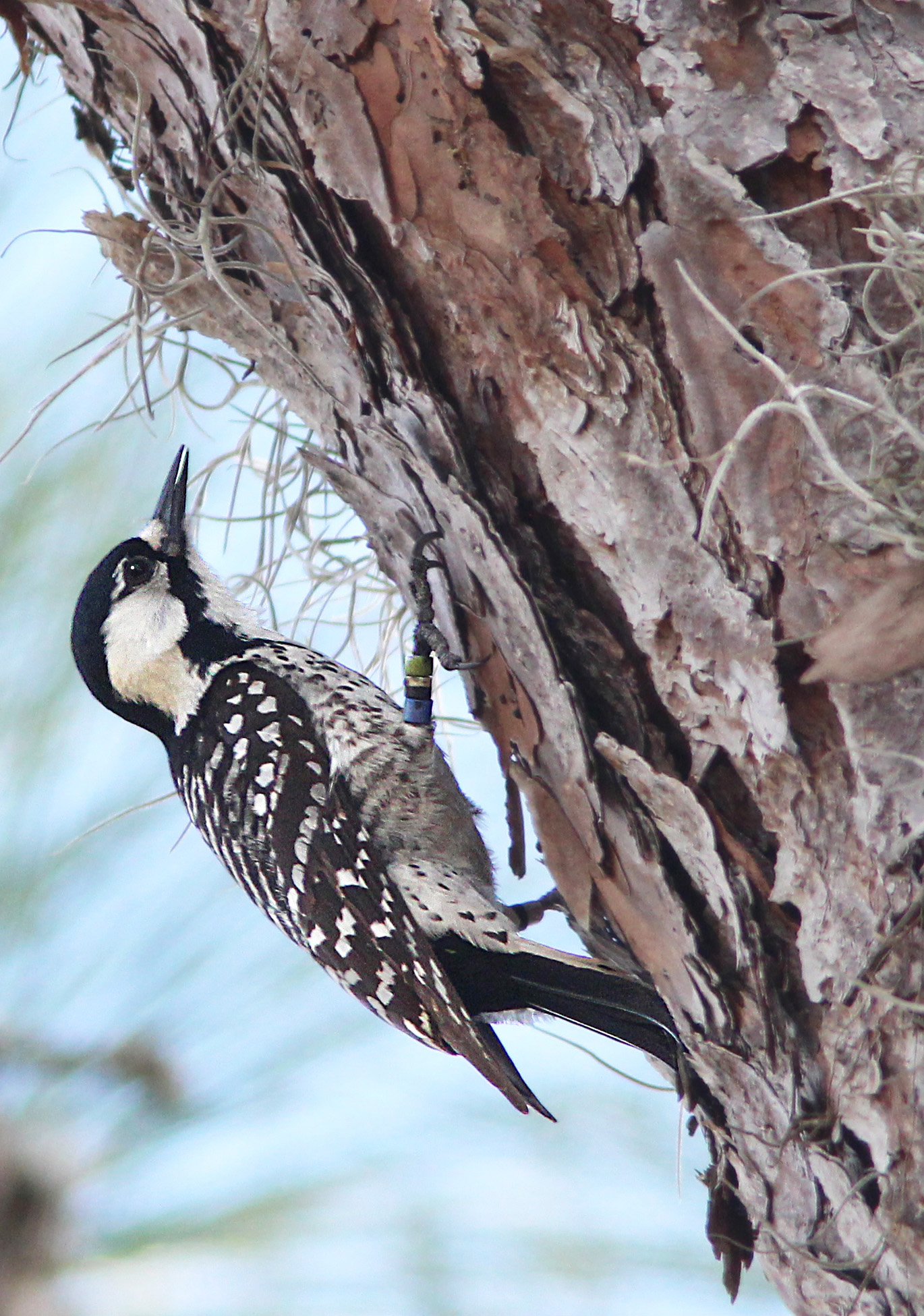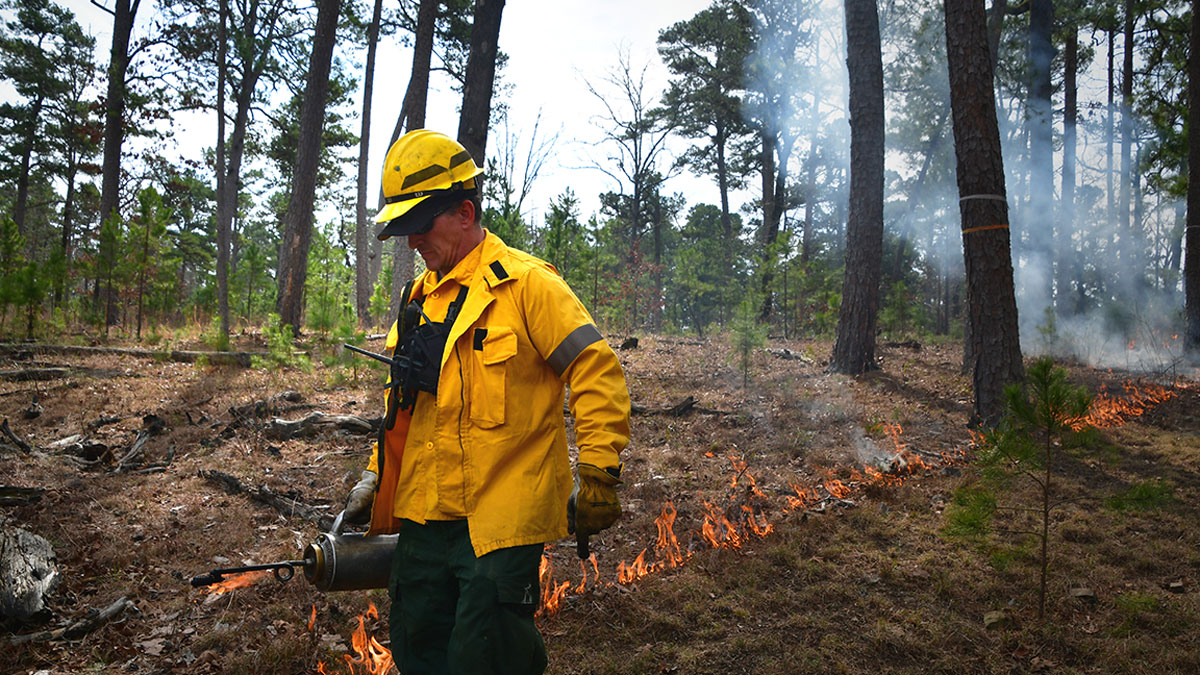Below is a news release from the Oklahoma Department of Wildlife Conservation. The Rocky Mountain Elk Foundation has long maintained that prescribed fire as a part of active forest management benefits habitat for elk and a myriad of wildlife and bird species, plus it improves overall forest health.
“It’s so much easier to use fire than to fight fire.”
Fire torch in hand, Wildlife Department biologist Clay Barnes sets off down a steep slope of the McCurtain County Wilderness Area, igniting one edge of a 4,352-acre prepared burn unit as he goes.
“Today, we’re using fire to improve wildlife habitat,” Barnes said. “The ground will be black for a few weeks, but it won’t take long for native grasses and wildflowers to start coming up through the black. Prescribed fire helps keep those grasses and wildflowers in the forest’s understory instead of being taken over by young pines and hardwoods.”
The Wilderness Area and its individual management units are on a staggered prescribed burn schedule to maintain the open spaces between its towering pines and provide habitat for Oklahoma’s only remaining population of federally endangered red-cockaded woodpeckers.
Barnes has taken part in management efforts on the McCurtain County Wilderness Area, the Wildlife Department’s oldest management area, for 19 years and has seen the benefits of prescribed fire firsthand.
“Without fire, we would quickly lose suitable woodpecker habitat due to hardwood and midstory encroachment,” Barnes said. “We generally get enough annual rainfall, which promotes significant vegetative growth, that we also need to do some level of mechanical thinning on top of our regular burn rotation.”

Red-cockaded woodpeckers live in and forage for insects on mature shortleaf pines, but they prefer an open pine forest with big trees spaced far apart. That allows the birds to freely maneuver across the habitat and better avoid predators like raptors. Widely spaced trees also help prevent climbing snakes from accessing the nest or roost trees by way of overlapping tree branches.
“Fire is a much more effective – and cheaper – management tool than some of our other options for keeping the forest open. It would take years to set back as many growing saplings by hand or by machine as we can with one day of prescribed fire.”
Teamwork Makes the Dream Work
A properly managed forest benefits everyone, so the Wildlife Department joins forces – and resources – with the adjoining National Forest Service on burn day.
The 4,352-acre burn unit encompasses 3,430 acres of the Wildlife Department’s McCurtain County Wilderness Area and 922 acres of the Ouachita National Forest.
Ignition and suppression crews from both agencies work together to light the fire according to the predetermined ignition plan and to make sure the fire stays within the burn unit.
“We’ve been assigned most of the western and southern legs of this burn unit,” Barnes said. “And Forest Service crew members – including a few hotshot crews from as far away as New Mexico, Colorado, and Montana – are responsible for the northern and eastern legs.
“Once we get the edges blacked in, a Forest Service helicopter crew will then fly over the bulk of the unit and drop something called ‘Delayed Aerial Ignition Devices’ – which are basically flammable Ping-Pong-sized balls – to ignite the bulk of the burn unit.
“The helicopter saves us a lot of time, and lights fuel within the burn unit’s roughest terrain,” Barnes said. “If it weren’t for the Forest Service crew, and their helicopter, we wouldn’t be able to burn like we do. It just wouldn’t be possible.”
Prescribed Fire Strategy: A Cornerstone of Wildlife and Habitat Management
For many people, the word “fire” is associated with destruction. But for wildlife and habitat managers, fire is most often associated with regrowth.
“So many of our wildlife species are adapted to and thrive with the benefits of fire,” Barnes said. “Fire releases nutrients into the soil, promotes plant growth, and creates a diverse and viable habitat for wildlife. It’s all connected.”
While fire is a natural part of Oklahoma’s many ecosystems, Barnes and his fellow biologists around the state still strategize how to best use fire to get the greatest good for our wildlife populations and their habitats, especially when sensitive habitats are involved.
At the Wilderness Area, mature pine trees used by the red-cockaded woodpecker for nesting or roosting are among the most sensitive of habitats. The birds form family groups and live in cavities in a group, or cluster, of trees. When that cluster is within a scheduled burn unit, Barnes takes extra precautions to protect the trees from any inadvertent fire damage.
“These older shortleaf pines are really tough and withstand a fire really well. But we still visit the cluster before burn day and rake around the individual trees to reduce the fuel loads right next to the trees. And we’ll go back to the cluster on the day of the burn to light a low-intensity fire around the trees for added protection.”
Trees with nest or roost cavities used by red-cockaded woodpeckers are marked by white paint and are visited by biologists prior to a prescribed burn. Leaves, pine needles, and other fuels have been raked away from a 3-foot radius of this cavity tree. A low-intensity fire was also lighted around the tree to further protect it from any inadvertent damage of the larger prescribed burn.
Barnes also strategizes the timing of the scheduled prescribed burns to maintain the woodpecker’s habitat.
“Right now, we’re burning in the dormant season. But we’re considering the benefits of adding smaller scale growing season burns into the rotation. Those units would be less than 1,000 acres in size and would be burned sometime between July and September instead of December through March. A growing season burn would be more effective in managing hardwood encroachment as it wilts the leaves and ruptures the bark of sapling trees.”
While the Wilderness Area’s primary focus is maintaining and improving habitat for the red-cockaded woodpecker, the same management efforts that benefit the woodpecker also benefit other species.
“A lot of songbirds will nest and feed in the same areas as the woodpeckers. And the newly burned areas will have lots of green grass and flowering plants later this spring and summer – that will be great for turkey hens and poults and does and fawns.”
To ensure habitat is available to species beyond red-cockaded woodpeckers throughout the year, the Wildlife Department staggers its prescribed burning efforts.
“We burn our units on a three-year rotation,” Barnes said. “That means almost every unit gets the benefit of a prescribed fire in a three-year period, but that also means we’re leaving unburned habitat for turkeys to nest in and does and fawns to bed in every year.
“A prescribed fire really is the best tool we have to manage so many acres. We have to strategize the best way to apply it as a management tool, but the results to our wildlife populations and habitats are proof that it works.”
Prescribed burning efforts on the McCurtain County Wilderness Area are funded in part by the Wildlife Department and the U.S. Fish and Wildlife Service’s Wildlife and Sport Fish Restoration Program grant F21AF02826.
(Photo credit: Oklahoma Department of Wildlife Conservation)
